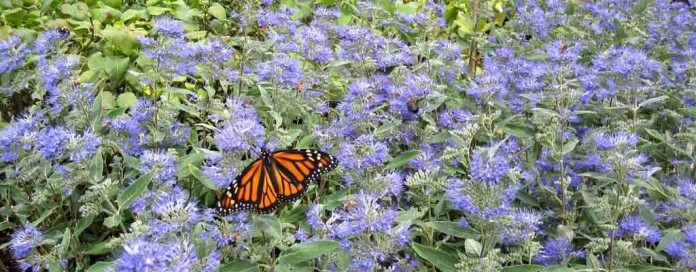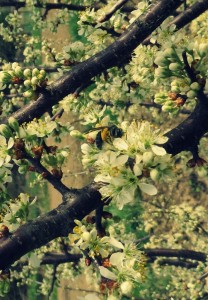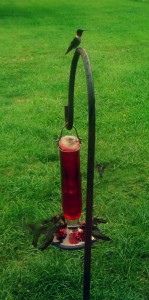Pollination is the process of moving pollen from flower to flower. Bees, birds, butterflies, bats and bugs are live pollinators. The wind also acts as a pollinator for some plants. Successful production of fruit, vegetables and seeds depends on good pollination.
Loss of habitat, overuse of chemicals, diseases and parasites result in less pollinators and a less secure food system. Providing pollinators with food, water and shelter supports strong plant production; plus you get to enjoy the beauty that hummingbirds, bees, butterflies and other pollinators bring to your yard!
Food
Pollinators get protein from pollen. They get sugar, amino acids and other vital nutrients from nectar. Just as humans benefit from eating a diverse diet, pollinators benefit from dining on an array of plants. Planting flowers, vegetables, trees and shrubs with bloom periods spanning from early spring to late fall ensures pollinator food security.
Early spring is a critical time to feed bees. Bees leave the winter hive for first flights before most food sources have blossomed. I set homemade fondant out to feed foraging bees. Rotting fruit feeds butterflies and hosts their larvae. Butterflies also benefit from exposed ground to rest and consume soil minerals. Hang hummingbird feeders before the buzzing beauties arrive in your area to encourage them to nest nearby.
Although all pollen and nectar producing flowers attract pollinators to your yard, pollinators are most attracted to red, purple, blue and yellow flowers. Flowers with tube, funnel or cup shapes are preferred. Here are a few ideas:
- Wild columbine (red, yellow) blooms May-June
- Blazing star (purple) blooms May-August
- Lobelia (red, blue, purple) blooms July-October
- Bee balm (red) blooms July-October
- Salvia (purple) blooms April-June
Don’t forget weeds feed pollinators. You might hate to see dandelions, violets, creeper vine and milkweed in your yard, but to pollinators it looks like an all-you-can eat buffet!
Water
Fill a birdbath or structure with fresh water for pollinators to drink and bathe if there is not a natural source of water nearby. Providing water for pollinators is especially important during the dog days of summer.
Shelter
Planting in clusters allows pollinators to move though the landscape safe from predators. Cluster planting also encourages thorough pollination of plants because it allows pollinators to move easily from flower to flower. Different heights of plants create layers to support pollinator habitats. Trees and shrubs are the tallest layer in a yard. Tall grasses, flowers and climbing vines make the middle layer. Short stemmed flowers, vegetables and ground covers are the lowest layer. Tolerate some dead plant material and yard debris to provide nesting cavities for pollinators. Dead wood, branches, leaf litter and dirt piles make safe and happy homes.
Traditional herbicides and pesticides may kill your guests. If you use traditional chemicals, minimize use to target problem areas in the recommended amount. Natural and organic versions often work just as well and are safer for our pollinator friends.














